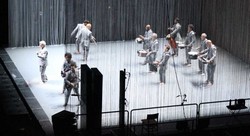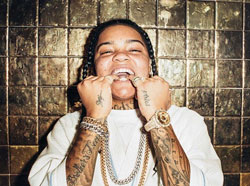David Byrne was “Burning Down the House” for a show on his American Utopia Tour at the OceanFirst Bank Center on Friday, Sept. 7.
The former Talking Heads frontman has been on tour since March to promote his first solo album in fourteen years, American Utopia.
It’s an album that can pick your brain apart, which Byrne presented to the crowd at the start of his show.
At 9:15 p.m., the arena was pitch dark as the spotlight casted on Byrne, who held a brain in his hand as he sat at a desk in the center of the stage. The artist was barefoot in a silver suit.
As Byrne sang the hypnotic closing track “Here” from his latest album, a set of white translucent curtains rose from the ground and climbed to the ceiling.
When the curtains reached the top, two figures in matching silver suits slowly emerged from the background to join Byrne in a chanting of his song.
Byrne could’ve been holding my brain, because my mind was lost in the artist’s spellbinding start.
After the introduction, the party began. For the next song, “Lazy,” Byrne stood center stage and nine bandmates were scattered around him.
Normally, when you attend a concert, the band will have their instruments prepared on the stage before they come out.
However, at Byrne’s show, his stage was an empty silver lot from the start.
Throughout the hour and 45 minute concert, the musicians didn’t have a stationary spot. All the instrumentalists, from percussion to string, stood and danced for each song.
It was impressive to see nine people dance around Byrne for “Lazy,” but in “I Zimbra,” three more instrumentalists took the stage to play and dance.
In total, the band consisted of ten instrumentalists and two backup singers.
For each song, players and singers shifted on and off the stage to provide their special talents.
The effort by Byrne and his band was stunning, because every song was uniquely choreographed.
Eight of the 21 songs played were from the Talking Heads. For the classic “Once in a Lifetime,” Byrne stood at front stage as the rest of his band stood behind him in a horizontal line.
When Byrne sang, he ran around the stage and looked as though he was about to trip at each step. It was like watching the famous 1980 music video in person.
The other Talking Heads song that made the audience jive was “Burning Down the House.”
The closing song of the show before the encore featured all twelve players dancing in formation like a high school marching band competition.
While many were bumping to the beat, others may have had flashbacks to their dark times at band camp.
Byrne also featured his solo work throughout the evening.
The artist’s latest hit, “Everybody is Coming to My House,” was accompanied by the complete band halfway through the show, as they danced around him like it was a house party.
Another song played of Byrne’s with the twelve piece band was “Everyday is a Miracle.”
It was a tribal celebration of life, as the bandmates and Byrne danced around in a circle for most of the song.
All they were missing was a firepit in the middle and they could’ve sang kumbaya.
To close out the concert, Byrne played a cover of Janelle Monáe’s “Hell You Talmbout,” which she sang at the Women’s March at Washington D.C. in 2015, but with his own twist.
The Afrobeat song is a tribute to African Americans killed by police brutality, with lyrics such as, “Eric Garner/SAY HIS NAME” and “Aiyana Jones/SAY HER NAME.”
Byrne came out with his percussionists and two backup singers, and yelled the names of those we lost to police brutality to the audience.
At 66-years-old, age becomes Byrne.
The artist was consistently dancing and running around the stage for the entirety of the show.
It made me take stock into my own life, for I occasionally dread walking three minutes to the dining hall for lunch.
At the end of the show, everyone stood to applaud Byrne’s incredible effort.
But you may ask yourself: well, how did Byrne get here?
Stuart Rosenberg, Ph.D., Department Chair of Management at the Leon Hess Business School and Professor of How Rock and Roll Shaped America, spoke of Byrne’s impact on the music world over his 47 year-long career.
Rosenberg said, “I think what has made David Byrne important to our popular culture is that his music has covered such a broad range of genres.
With his band, Talking Heads, and in his solo and collaborative projects, he has incorporated punk, art rock, world music, and funk into some of the most infectious pop songs of any era.”
What has helped Byrne remain prominent for so long is how he takes risk in music.
Rosenberg added, “Byrne is an innovator. His songs are not derivative.
A lot of musicians get comfortable with a particular formula that works for them. He does not.”
Even at this stage in his career, Byrne is at the top of his game.
Rosenberg concurred with, “He continues to introduce us to interesting musical styles while mixing in intelligently quirky lyrics.”
Byrne brings his unique talent to his albums and stage performance, which many were happy to witness last Friday night.
The final date of Byrne’s tour will be on Nov. 28 in Adelaide, Australia.
PHOTO TAKEN by Nicole Riddle




